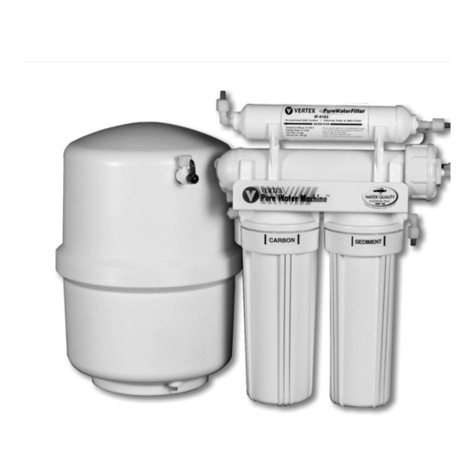-14-
Appendix A: Theory Of Operation
A.1 Pre-Filters
The pre-filters have two purposes, one is to clean the water for better consump-
tion, and the second is to prevent the RO membrane from being polluted. The first
stage filter removes sediment materials such as sand, rust, pipe scale, and dirt. It is
made of a spun polypropylene material that will take out particles down to 5 -
microns.
The water then goes to the carbon block filters, which are important for two rea-
sons. The first takes out 90% of the chlorine in the water thereby protecting the RO
membrane from damage by the presence of chlorine. It also removes the taste of the
chlorine, as well as other tastes and odors that affect the drinking water . (The carbon
accomplishes this by adsorption on its surface). This is a chemical/mechanical
process unique to carbon that has been activated -made to have high surface area. The
second Carbon Block filter is there to also takes out VOCs (volatile organic chemi-
cals) which are contaminants from industrial pollution.
Flow Schematic (Figure A-1)
-15-
A.2 The Reverse Osmosis Membrane
This is the heart of the machine, and the great protector. The membrane is a replica-
tion of human or animal stomach tissue, which permits the water molecule to pass
through, but holds the dissolved molecules back. This occurs naturally by osmotic pres-
sure developed because of the content of dissolved solids. To make this happen with the
RO membrane we reverse the osmotic pressure by applying pressure to the water (revers-
ing the process of generating pressure) to push the water molecules through the mem-
brane, but keeping most of the dissolved solid molecules behind. “Most” means about
70% of nitrates and 99% of copper, lead, and other high molecular weight material.
The reverse osmosis technology will, on average, reject 93% of the total dissolved
solids in the incoming water. Over time, the RO membrane will foul with a very thin
layer of materials and the efficiency will drop, so that the TDS content of the clean water
will rise. When it rises to greater than 30% of the inlet TDS value, it is an indicator that
the RO membrane should be replaced. This occurs every 3-4 years. (See Section 4)
About 4 gallons of water is discarded for every gallon of pure water made. In
Figure A- 1, the discard is shown with a flow control orifice at the outlet of the RO
stage. This is designed to hold back the discard water to the above ratio, and maintain
pressure on the water in the membrane. For a 75-gallon per day membrane, approxi-
mately 668 milliliters per minute of water are discarded. Note there is a check valve
on the clean water outlet from the RO. The purpose is to prevent backflow of water
to the membrane from the tank or faucet or because of autovalve failure. In the aver-
age household, about 3 gallons of drinking water are used a day.
A.3 Auto Control
As water is produced the pressure in the storage tank increases. To stop production
of water when the tank is full, an auto control valve is used in the system, as shown in
Figure A-1. The pressure in the tank is set nominally to be 2/3 of the incoming line
pressure. When this ratio is reached the autovalve will close. Normal U.S. city water
pressure is 60-psi, therefore the tank pressure, when water flow stops, is 40-psi.
The purified water goes to the tank where it is stored at pressure as described
above. The tank has a bladder in it, and on one side is air at 6-psi, initially. The ini-
tial volume of the storage tank is 4.0 gallons. As the water fills the tank, it pushes
against the bladder, and raises the pressure as it takes space in the tank. When the pres-
sure increases to 40-psi, water flow stops. The net amount of water in the tank when
full, less the space taken by the air at 40-psi is approximately 2.5 gallons. When
water is drawn through the clean water faucet on the sink, the water flows through
the final activated carbon post filter, which polishes the water by taking out any stal-
eness which has set in.When water is supplied to the refrigerator, the line should be
therefore taken after the post filter.
When the raw feed water pressure available is 40-psi or less, the RO membrane
will not operate efficiently or produce water at a reasonable rate. To overcome this use
a system with a booster pump which will raise the water pressure in the system to
about 80-psi.
Rev. 8/08
Copyright VERTEX Industrials, Inc. 2008





























